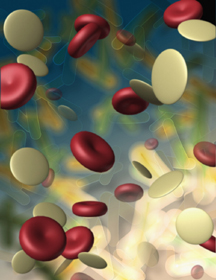Hemophilia
Hemophilia is a disorder in which a person's blood is not able to clot normally. In normal blood, proteins called clotting factors work together to form a clot whenever bleeding occurs. A person with hemophilia lacks or doesn't have enough of a certain clotting factor so the blood can't make a clot.
This is not a problem when a person with hemophilia has a simple cut or scrape. They don't bleed any faster than the average person. They can hold pressure on the cut and platelets in the blood will stop the bleeding.
The problem for people with hemophilia is bleeding inside the body, especially bleeding into joints like the knees, elbows, and ankles. When bleeding happens inside the joint, it becomes very swollen and painful. Repeated bleeding into a joint can cause a type of crippling arthritis. Bleeding inside other parts of the body, such as the brain, throat, and abdomen can be life-threatening.
Hemophilia is classified as either mild, moderate or severe, depending on the amount of clotting factor a person has in his body. Severe hemophilia is actually the most common form. A person with severe hemophilia has less than 1% of the normal amount of a clotting factor - either factor VIII (8) or factor IX (9). People without hemophilia have between 50-150% of the normal level of factor VIII or IX.
A person with mild hemophilia may only have problems with bleeding when he has surgery, major dental work, or a severe injury. A person with moderate hemophilia will have those problems plus bleeding problems with more minor injuries such as a hard bump to the knee. A person with severe hemophilia can have what are called spontaneous bleeds - bleeding that starts inside the body for no known reason.
Who gets hemophilia?
People with hemophilia are born with the disorder and have it all of their lives. Hemophilia is a genetic disorder - it is passed down generation to generation through a family's genes. Because the genetic defect occurs on the X chromosome, women are carriers of hemophilia but rarely have the disorder. Hemophilia occurs almost exclusively in men.
In about one-third of the babies born with hemophilia, the disorder is believed to be due to a spontaneous mutation of the gene. There is no family history of hemophilia.
How common is hemophilia?
Hemophilia is a very rare disorder. Very few people have it. There are about 17,000 people in the United States with hemophilia. One out of every 5,000 boys born has hemophilia. This makes it about as rare as triplets (three babies in one birth).
Is there a cure for hemophilia? What treatment is available?
There is no cure for hemophilia at this time, but much promising research is being done. People with hemophilia stop bleeding by taking an injection of the clotting factor that is missing from their blood. Some people with hemophilia give themselves this injection; others go to a hospital or clinic for treatment. By using clotting factor and visiting a doctor or hemophilia clinic regularly, a person with hemophilia can expect to have a normal lifespan.
The clotting factor used to treat hemophilia is very expensive. A common type of bleeding, into a joint, can cost $200 to $6,000 to treat one time, depending on the person's weight. A person with hemophilia may spend from $40,000 to over $200,000 each year for his medical care.
Where Can I Learn More about Hemophilia?
You can learn more online by visiting the National Bleeding Disorders Foundation and the World Federation of Hemophilia.